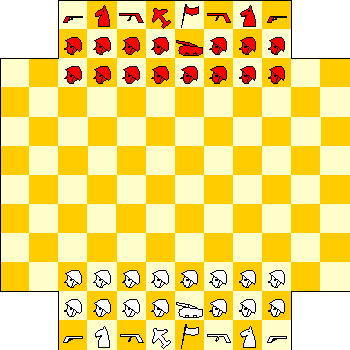Chess-Battle
This is a game from the Soviet-Union, invented in 1933 by A.S. Yurgelevich. It was described in Pritchard's Encyclopedia of Chess Variants.
Rules
The game is played on a board of 128 squares, obtained by adding to all four sides of a regular eight by eight board a strip of two by eight (or eight by two) squares. Players have each twenty-four pieces: a headquarter, a bomber, a tank, two guns, two cavalry, two machine-guns, and fifteen soldiers.
Opening setup
The opening setup is as follows. Player colours are red and white.
 The
board is formed by adding two rows of eight squares at each of the four
sides of an 8 by 8 board. Squares are alternatingly colored, with black
in the lower-left corners.
The
board is formed by adding two rows of eight squares at each of the four
sides of an 8 by 8 board. Squares are alternatingly colored, with black
in the lower-left corners.
White:
Flag g1; Gun c1, j1; Cavalry d1, i1, Machine-gun e1, h1; Bomber f1;
Tank g2; Soldier c2, c3, d2, d3, e2, e3, f2, f3, g3, h2, h3, i2, i3, j2,
j3, h2, h3.
Black:
Flag g12; Gun c12, j12; Cavalry d12, i12, Machine-gun e12, h12; Bomber
f12; Tank g11; Soldier c11, c10, d11, d10, e11, e10, f11, f10, g10, h11,
h10, i11, i10, j11, j10, h11, h10.
Moves
The headquarter moves as a king, and also plays the role of king.
The bomber moves and takes as a queen, but may also jump over one friendly piece (but not over more than one friendly piece per turn). The bomber cannot be taken by a tank or by cavalry.
The tank moves one or two squares horizontally, vertically or diagonally. The tank cannot be taken by a machine-gun, cavalry, or soldier.
When the gun moves, it cannot take, and moves as a king one square in an arbitrary direction. Guns take by shooting. In this case, the gun does not move, but can take one hostile piece that is at most five squares away in a horizontal, diagonally forward, or vertically forward direction. A gun can shoot only one piece in a turn. Shooting counts as a whole turn. Guns may shoot over their own pieces.
The machine-gun moves as the gun: it cannot take when moving and goes one square in an arbitrary direction. The machine-gun also takes by shooting; however the machine-gun may shoot in all eight directions (horizontal, vertical, or diagonal), but only at most three squares far. Again, when shooting, the machine-gun doesn't move; shooting counts as a whole turn and at most one piece is shot in the turn. Also, a machine-gun may not shoot over another piece, i.e., when the machine-gun shoots another piece, the squares in between should be empty.
The cavalry has a number of moves, resembling the moves of a knight, but a little differently. When moving a cavalry, the player may make a normal knight move (1 square in one horizontal or vertical direction, and two in the other direction), or make a move of 1 square in one (horizontal or vertical) direction and three in the other direction, or make a move of 2 squares in one (horizontal or vertical) direction and three in the other direction. So, when a cavalry would be on a normal chess board on the square a1, it can move to b3, c2, b4, d2, c4 and d3. It may jump over friendly pieces, but not over enemy pieces.
A soldier has two possible moves: as a king, i.e., one square in an arbitrary direction, or when it is on a white square, it may move (without jumping over another piece) two squares in an arbitrary direction (horizontal, vertical, diagonal). However, a soldier can only take a piece, when he moves one square horizontally, or forward, i.e., he cannot take when going two squares or when moving backwards.
Other rules
Soldiers do not promote. Instead, when a soldier moves to the last rank of the board (the rank that contains in the opening setup the opponents headquarter), then the player owning the soldier, removes the soldier, and one piece of the opponent, but not the headquarter, from the board.
Purpose of the game is to mate the opponents headquarter.
Written by Hans Bodlaender. Thanks to Jean-Louis Cazaux for several corrections.
Version without graphics
WWW page created: December 4, 1996. Last modified: December 4, 1998.